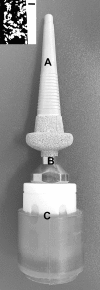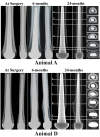Variation in bone response to the placement of percutaneous osseointegrated endoprostheses: A 24-month follow-up in sheep
- PMID: 31652276
- PMCID: PMC6814231
- DOI: 10.1371/journal.pone.0221850
Variation in bone response to the placement of percutaneous osseointegrated endoprostheses: A 24-month follow-up in sheep
Abstract
Percutaneous osseointegrated (OI) devices for amputees are metallic endoprostheses, that are surgically implanted into the residual stump bone and protrude through the skin, allowing attachment of an exoprosthetic limb. In contrast to standard socket suspension systems, these percutaneous OI devices provide superior attachment platforms for artificial limbs. However, bone adaptation, which includes atrophy and/or hypertrophy along the extent of the host bone-endoprosthetic interface, is seen clinically and depends upon where along the bone the device ultimately transfers loading forces to the skeletal system. The goal of this study was to determine if a percutaneous OI device, designed with a porous coated distal region and an end-loading collar, could promote and maintain stable bone attachment. A total of eight, 18 to 24-month old, mixed-breed sheep were surgically implanted with a percutaneous OI device. For 24-months, the animals were allowed to bear weight as tolerated and were monitored for signs of bone remodelling. At necropsy, the endoprosthesis and the surrounding tissues were harvested, radiographically imaged, and histomorphometrically analyzed to determine the periprosthetic bone adaptation in five animals. Bone growth into the porous coating was achieved in all five animals. Serial radiographic data showed stress-shielding related bone adaptation occurs based on the placement of the endoprosthetic stem. When collar placement and achieved end-bearing against the transected bone, distal bone conservation/hypertrophy was observed. The results supported the use of a distally loading and distally porous coated percutaneous OI device to achieve distal host bone maintenance.
Conflict of interest statement
The authors have declared that no competing interests exist.
Figures







References
-
- Hagberg K, Branemark R. One hundred patients treated with osseointegrated transfemoral amputation prostheses—rehabilitation perspective. J Rehabil Res Dev. 2009;46(3):331–44. Epub 2009/08/14. . - PubMed
Publication types
MeSH terms
LinkOut - more resources
Full Text Sources

